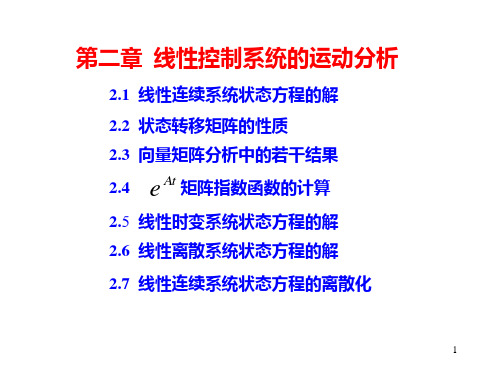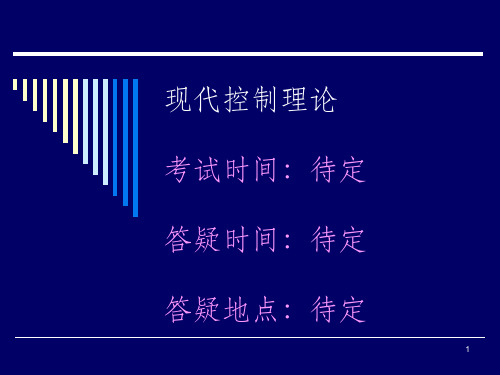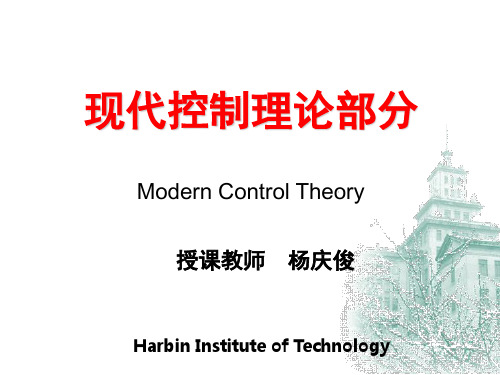华南理工大学现代控制理论课件-1
合集下载
《现代控制理论》课件

现代控制理论
目录
• 引言 • 线性系统理论 • 非线性系统理论 • 最优控制理论 • 自适应控制理论 • 鲁棒控制理论
01
引言
什么是现代控制理论
现代控制理论是一门研究动态系统控制的学科,它利用数学模型和优化方法来分析 和设计控制系统的性能。
它涵盖了线性系统、非线性系统、多变量系统、分布参数系统等多种复杂系统的控 制问题。
20世纪60年代
线性系统理论和最优控制理论得到发展,为现代控制理论的建立奠定 了基础。
20世纪70年代
非线性系统理论和自适应控制理论逐渐发展起来,进一步丰富了现代 控制理论的应用范围。
20世纪80年代至今
现代控制理论在智能控制、鲁棒控制、预测控制等领域取得了重要进 展,为解决复杂系统的控制问题提供了更有效的工具。
01
利用深度学习算法对系统进行建模和学习,实现更高
效和智能的自适应控制。
多变量自适应控制
02 研究多变量系统的自适应控制方法,以提高系统的全
局性能。
非线性自适应控制
03
发展非线性系统的自适应控制方法,以处理更复杂的
控制系统。
06
鲁棒控制理论
鲁棒控制的基本概念
鲁棒控制是一种设计方法,旨在 提高系统的稳定性和性能,使其 在存在不确定性和扰动的情况下
自适应逆控制
一种基于系统逆动态特性的自适应控制方法,通过对系统 逆动态特性的学习和控制,实现系统的自适应控制。
自适应控制系统设计
系统建模
建立被控对象的数学模型,包括线性系统和非线性系统。
控制器设计
根据系统模型和性能指标,设计自适应控制器,包括线性自适应控制器和 非线性自适应控制器。
参数调整
根据系统运行状态和环境变化,调整控制器参数,以实现最优的控制效果 。
目录
• 引言 • 线性系统理论 • 非线性系统理论 • 最优控制理论 • 自适应控制理论 • 鲁棒控制理论
01
引言
什么是现代控制理论
现代控制理论是一门研究动态系统控制的学科,它利用数学模型和优化方法来分析 和设计控制系统的性能。
它涵盖了线性系统、非线性系统、多变量系统、分布参数系统等多种复杂系统的控 制问题。
20世纪60年代
线性系统理论和最优控制理论得到发展,为现代控制理论的建立奠定 了基础。
20世纪70年代
非线性系统理论和自适应控制理论逐渐发展起来,进一步丰富了现代 控制理论的应用范围。
20世纪80年代至今
现代控制理论在智能控制、鲁棒控制、预测控制等领域取得了重要进 展,为解决复杂系统的控制问题提供了更有效的工具。
01
利用深度学习算法对系统进行建模和学习,实现更高
效和智能的自适应控制。
多变量自适应控制
02 研究多变量系统的自适应控制方法,以提高系统的全
局性能。
非线性自适应控制
03
发展非线性系统的自适应控制方法,以处理更复杂的
控制系统。
06
鲁棒控制理论
鲁棒控制的基本概念
鲁棒控制是一种设计方法,旨在 提高系统的稳定性和性能,使其 在存在不确定性和扰动的情况下
自适应逆控制
一种基于系统逆动态特性的自适应控制方法,通过对系统 逆动态特性的学习和控制,实现系统的自适应控制。
自适应控制系统设计
系统建模
建立被控对象的数学模型,包括线性系统和非线性系统。
控制器设计
根据系统模型和性能指标,设计自适应控制器,包括线性自适应控制器和 非线性自适应控制器。
参数调整
根据系统运行状态和环境变化,调整控制器参数,以实现最优的控制效果 。
1.2-现代控制理论的主要内容PPT优秀课件

6
最优控制(1/1)
1.2.2 最优控制
最优控制理论是研究和解决从一切可能的控制方案中寻找最 优解的一门学科。 ➢ 具体地说就是研究被控系统在给定的约束条件和性能指 标下,寻求使性能指标达到最佳值的控制规律问题。 ➢ 例如要求航天器达到预定轨道的时间最短、所消耗的燃 料最少等。
该分支的基本内容和常用方法为 ➢ 变分法; ➢ 庞特里亚金的极大值原理; ➢ 贝尔曼的动态规划方法。
8
随机系统理论和最优估计(2/2)
最优估计讨论根据系统的输入输出信息估计出或构造出随机 动态系统中不能直接测量的系统内部状态变量的值。 ➢ 由于现代控制理论主要以状态空间模型为基础,构成反馈 闭环多采用状态变量,因此估计不可直接测量的状态变量 是实现闭环控制系统重要的一环。 ➢ 该问题的困难性在于系统本身受到多种内外随机因素扰 动,并且各种输入输出信号的测量值含有未知的、不可测 的误差。
系统辨识是重要的建模方法,因此亦是控制理论实现和应用 的基础。 ➢ 系统辨识是控制理论中发展最为迅速的领域,它的发展还 直接推动了自适应控制领域及其他控制领域的发展。
11
自适应控制(1/5)
1.2.5 自适应控制
自适应控制研究当被控系统的数学模型未知或者被控系统的 结构和参数随时间和环境的变化而变化时,通过实时在线修正 控制系统的结构或参数使其能主动适应变化的理论和方法。 ➢ 自适应控制系统通过不断地测量系统的输入、状态、输 出或性能参数,逐渐了解和掌握对象,然后根据所得的信息 按一定的设计方法,做出决策去更新控制器的结构和参数 以适应环境的变化,达到所要求的控制性能指标。 ➢ 该分支诞生于1950年代末,是控制理论中近60年发展最为 迅速、最为活跃的分支。
12
自适应控制(2/5)
最优控制(1/1)
1.2.2 最优控制
最优控制理论是研究和解决从一切可能的控制方案中寻找最 优解的一门学科。 ➢ 具体地说就是研究被控系统在给定的约束条件和性能指 标下,寻求使性能指标达到最佳值的控制规律问题。 ➢ 例如要求航天器达到预定轨道的时间最短、所消耗的燃 料最少等。
该分支的基本内容和常用方法为 ➢ 变分法; ➢ 庞特里亚金的极大值原理; ➢ 贝尔曼的动态规划方法。
8
随机系统理论和最优估计(2/2)
最优估计讨论根据系统的输入输出信息估计出或构造出随机 动态系统中不能直接测量的系统内部状态变量的值。 ➢ 由于现代控制理论主要以状态空间模型为基础,构成反馈 闭环多采用状态变量,因此估计不可直接测量的状态变量 是实现闭环控制系统重要的一环。 ➢ 该问题的困难性在于系统本身受到多种内外随机因素扰 动,并且各种输入输出信号的测量值含有未知的、不可测 的误差。
系统辨识是重要的建模方法,因此亦是控制理论实现和应用 的基础。 ➢ 系统辨识是控制理论中发展最为迅速的领域,它的发展还 直接推动了自适应控制领域及其他控制领域的发展。
11
自适应控制(1/5)
1.2.5 自适应控制
自适应控制研究当被控系统的数学模型未知或者被控系统的 结构和参数随时间和环境的变化而变化时,通过实时在线修正 控制系统的结构或参数使其能主动适应变化的理论和方法。 ➢ 自适应控制系统通过不断地测量系统的输入、状态、输 出或性能参数,逐渐了解和掌握对象,然后根据所得的信息 按一定的设计方法,做出决策去更新控制器的结构和参数 以适应环境的变化,达到所要求的控制性能指标。 ➢ 该分支诞生于1950年代末,是控制理论中近60年发展最为 迅速、最为活跃的分支。
12
自适应控制(2/5)
第2章 现代控制理论1PPT课件

时不变系统状态转移矩阵Φ tt0或 Φ t是满足如下矩阵微分
方程和初始条件的解,这也是检验一个矩阵是不是状态转移
的条件。
Φ (tt0)AΦ (tt0)或 Φ (t)AΦ (t)
Φቤተ መጻሕፍቲ ባይዱ(0)I
Φ (0)I
(2.5)
1Φ t在 t0的值 lim ΦtI
t0
(2)Φt对t的导 Φ 数 tA Φ tΦ tA
故可求出其解为:
t
X ( t) ( t) X ( 0 ) o ( t ) B () U d ( 2 .2 b )
式中 (t) eAt 为系统的状态转移矩阵。
对于线性时变系统非齐次状态方程,
X ( t) A ( t) X ( t) B ( t) U ( t) ( 2 3 )
类似可求出其解为
x (0 )e a t tb(u )e a (t )d 0
同样,将方程(2.1)写为 X (t)A(X t)B(U t)
在上式两边左乘eAt ,可得:
e A [X t(t) A(t) X ]d[e AX t(t) ]e A B t (tU )
dt
3
将上式由 0 积分到 t ,得
X ( t) e A X t ( 0 ) te A (t )B () U d (2 .2 a ) o
的解,X(t)=Ф (t, t0)X(0) 。 下面不加证明地给出线性时变系统状态转移矩阵的几个
重要性质: 1、 (t,t)I
2 、 ( t 2 ,t 1 ) ( t 1 ,t 0 ) ( t 2 ,t 0 )
3 、 1 (t,t0) (t0 ,t) 4、当A给定后,(t,t0) 唯一
5、计算时变系统状态转移矩阵的公式
令 x (t) b 0 b 1 t b 2 t2 b iti b iti,t 0
华南理工大学现代控制理论复习知识点PPT课件

2
第一章复习要点
1. 建立连续时间系统的状态空间表达式
系统结构图建立
转化为有积分号的模拟图,取状态变量,根据变量 关系写出一阶微分方程组,状态空间表达式
系统机理(电气系统、动力学系统)
取状态变量,建立微分方程,整理,写出状态空间 表达式
传递函数
能控标准I型(直接写出),能观标准II型(B计算系数)
状态反馈:前提:系统完全能控
直接方法: 1) f(I (A+BK)) 2) f*() 3) f()与f*()比较得出K;
间接方法: 1) A变换为能控标I型,Tc1,A’, -> (a’0, … a’n-1 ); 2) 闭环系统新的多项式: f*(); 3) 计算K=K’ Tc1-1, K’i= a’I a*i
1、状态反馈
原理:状态反馈增益矩阵K… 结构图? 特点:改变闭环系统的特征值,可配置极点
2、输出反馈
原理:输出反馈增益矩阵H… 结构图? 特点:
3、闭环系统的能控性、能观性
状态反馈不改变系统的能控性,但不保证能观性不变 输出反馈不改变系统的能控性和能观性
21
第五章复习要点
4、极点配置
17
第四章复习要点
第二方法:平衡状态xe,满足f(xe)=0。 若存在标量函数V(x),满足:
V(x)对所有x都具有连续的一阶偏导 V(x)正定,即当x=0,V(x)=0; x0,V(x) >0; V(x)沿状态轨迹方向计算的时间导数V’(x)满足条件: V’(x)半负定(0):xe李亚普诺夫意义下稳定; V’(x)负定,或V’(x)半负定(0)但除x=0外V’(x)不恒为
12
第三章复习要点
3、标准型及转化 (单输入单输出,系统能控)
第一章复习要点
1. 建立连续时间系统的状态空间表达式
系统结构图建立
转化为有积分号的模拟图,取状态变量,根据变量 关系写出一阶微分方程组,状态空间表达式
系统机理(电气系统、动力学系统)
取状态变量,建立微分方程,整理,写出状态空间 表达式
传递函数
能控标准I型(直接写出),能观标准II型(B计算系数)
状态反馈:前提:系统完全能控
直接方法: 1) f(I (A+BK)) 2) f*() 3) f()与f*()比较得出K;
间接方法: 1) A变换为能控标I型,Tc1,A’, -> (a’0, … a’n-1 ); 2) 闭环系统新的多项式: f*(); 3) 计算K=K’ Tc1-1, K’i= a’I a*i
1、状态反馈
原理:状态反馈增益矩阵K… 结构图? 特点:改变闭环系统的特征值,可配置极点
2、输出反馈
原理:输出反馈增益矩阵H… 结构图? 特点:
3、闭环系统的能控性、能观性
状态反馈不改变系统的能控性,但不保证能观性不变 输出反馈不改变系统的能控性和能观性
21
第五章复习要点
4、极点配置
17
第四章复习要点
第二方法:平衡状态xe,满足f(xe)=0。 若存在标量函数V(x),满足:
V(x)对所有x都具有连续的一阶偏导 V(x)正定,即当x=0,V(x)=0; x0,V(x) >0; V(x)沿状态轨迹方向计算的时间导数V’(x)满足条件: V’(x)半负定(0):xe李亚普诺夫意义下稳定; V’(x)负定,或V’(x)半负定(0)但除x=0外V’(x)不恒为
12
第三章复习要点
3、标准型及转化 (单输入单输出,系统能控)
现代控制理论第一章 控制系统数学模型课件

现代控制理论第一章 控制系统数学模型
1.2.1 微分方程中不含有输入信号导数项
首先考察三阶系统,其微分方程为
选取状态变量
则有 x1 x2
y a 2 y a 1y a 0yb 0 u
x1 y
x2 y
x3 y
x2 x3 x 3 a 0 x 1 a 1 x 2 a 2 x 3 b 0 u
写成矩阵形式
状态图为
现代控制理论第一章 控制系统数学模型
1.2 由微分方程求状态空间表达式
一个系统,用线性定常微分方程描述其输入和输出的关系。通过选择合适的状态变量,就 可以得到状态空间表达式。 这里分两种情况: 1、微分方程中不含输入信号导数项,(即1.2.1 中的内容)
2、微分方程中含有输入信号导数项,(即1.2.2 中的内容)
x Ax Bu y Cx Du
x1
x
x
2
x
n
u1
u
u
2
u
r
y1
y
y2
y
m
现代控制理论第一章 控制系统数学模型
a11 a1n
A
an1 ann nn
c11 c1n
C
cm1 cmnmn
b11 b1r
B
bn1 anr nr
d11 d1r
的状态。(状态变
状态空间——以所选择的一组状态变量为坐标轴而构成的正交线性空间,称为状态空 间。
现代控制理论第一章 控制系统数学模型
例:如下图所示电路, 为输u (入t )量,
为输出量u。C (t )
建立方程: 初始条件:
Ldd(ti)tR(ti)uC(t)u(t)
i C duC(t) dt
1.2.1 微分方程中不含有输入信号导数项
首先考察三阶系统,其微分方程为
选取状态变量
则有 x1 x2
y a 2 y a 1y a 0yb 0 u
x1 y
x2 y
x3 y
x2 x3 x 3 a 0 x 1 a 1 x 2 a 2 x 3 b 0 u
写成矩阵形式
状态图为
现代控制理论第一章 控制系统数学模型
1.2 由微分方程求状态空间表达式
一个系统,用线性定常微分方程描述其输入和输出的关系。通过选择合适的状态变量,就 可以得到状态空间表达式。 这里分两种情况: 1、微分方程中不含输入信号导数项,(即1.2.1 中的内容)
2、微分方程中含有输入信号导数项,(即1.2.2 中的内容)
x Ax Bu y Cx Du
x1
x
x
2
x
n
u1
u
u
2
u
r
y1
y
y2
y
m
现代控制理论第一章 控制系统数学模型
a11 a1n
A
an1 ann nn
c11 c1n
C
cm1 cmnmn
b11 b1r
B
bn1 anr nr
d11 d1r
的状态。(状态变
状态空间——以所选择的一组状态变量为坐标轴而构成的正交线性空间,称为状态空 间。
现代控制理论第一章 控制系统数学模型
例:如下图所示电路, 为输u (入t )量,
为输出量u。C (t )
建立方程: 初始条件:
Ldd(ti)tR(ti)uC(t)u(t)
i C duC(t) dt
现代控制理论第一章 ppt课件

作为贝尔实验室工程师, 关于热噪声、反馈系统稳定性、 电报、传真、电视、通信。
1889-1976
1.1 控制理论的发展历程
伯德,Hendrik Wade Bode
美国1905-1982
Bode was an American engineer, researcher, inventor, author and scientist,
of Dutch ancestry.
As a pioneer of modern control theory and electronic
telecommunications he revolutionized both the content and methodology of his chosen fields of research.
1.1 控制理论的发展历程
维纳,Norbert Wienner
1948年,维纳发表《控制论》,宣告了这门新兴学 科的诞生。这是他长期艰苦努力并与生理学家罗森 勃吕特等人多方面合作的伟大科学成果。
1964年1月,他由于“在纯粹数学和应用数学方面并 且勇于深入到工程和生物科学中去的多种令人惊异的 贡献及在这些领域中具有深远意义的开创性工作”荣 获美国总统授予的国家科学勋章。
1.1 控制理论的发展历程
维纳,Norbert Wienner
第一章,牛顿时间和柏格森时间 第二章,群和统计力学 第三章,时间序列、信息与通讯 第四章,反馈与振荡 第五章,计算机与神经系统 第六章,完形与普遍观念 第七章,控制论和精神病理学 第八章,信息、语言和社会 第九章,关于学习和自生殖机 第十章,脑电波与自行组织系统
1.1 控制理论的发展历程
伯德,Hendrik Wade Bode
1889-1976
1.1 控制理论的发展历程
伯德,Hendrik Wade Bode
美国1905-1982
Bode was an American engineer, researcher, inventor, author and scientist,
of Dutch ancestry.
As a pioneer of modern control theory and electronic
telecommunications he revolutionized both the content and methodology of his chosen fields of research.
1.1 控制理论的发展历程
维纳,Norbert Wienner
1948年,维纳发表《控制论》,宣告了这门新兴学 科的诞生。这是他长期艰苦努力并与生理学家罗森 勃吕特等人多方面合作的伟大科学成果。
1964年1月,他由于“在纯粹数学和应用数学方面并 且勇于深入到工程和生物科学中去的多种令人惊异的 贡献及在这些领域中具有深远意义的开创性工作”荣 获美国总统授予的国家科学勋章。
1.1 控制理论的发展历程
维纳,Norbert Wienner
第一章,牛顿时间和柏格森时间 第二章,群和统计力学 第三章,时间序列、信息与通讯 第四章,反馈与振荡 第五章,计算机与神经系统 第六章,完形与普遍观念 第七章,控制论和精神病理学 第八章,信息、语言和社会 第九章,关于学习和自生殖机 第十章,脑电波与自行组织系统
1.1 控制理论的发展历程
伯德,Hendrik Wade Bode
现代控制理论PPT第一章
13
d 3θ R f d 2θ fR + K e K m dθ K m + + + = u dt 3 L J dt 2 JL dt JL
dθ d 2θ , x3 = 2 dt dt
x1 = θ , x2 =
& 1 x1 0 x = 0 & 0 2 x3 & 0 − fR + K e K m JL
说明:( :(1 同一个系统状态变量的选取不是唯一的。 说明:(1)同一个系统状态变量的选取不是唯一的。 状态变量是相互独立的, (2)状态变量是相互独立的,个数等于微分方程的个数 状态变量在初始时刻的值,就是系统的初始状态。 (3)状态变量在初始时刻的值,就是系统的初始状态。
2012年 2012年5月3日星期四
现代控制理论基础---广东工业大学 现代控制理论基础---广东工业大学
−
1 1 x1 LC + L u x 0 2 0
7
1 x1 y= 2012年 2012年5月3日星期四 0 C x2
例2 机电系统(图1-2示) 机电系统(图1 (1)经典法(高阶微分方程)
x1 y = [1 0 0] x2 x3
11
现代控制理论基础---广东工业大学 现代控制理论基础---广东工业大学
二 状态变量和状态矢量
状态是系统的运动状态, 状态是系统的运动状态,状态变量是完全表征系统运动状态的 且个数最少的一组变量。例如n阶微分方程描述的系统就有 阶微分方程描述的系统就有n 且个数最少的一组变量。例如 阶微分方程描述的系统就有 个独立的状态变量。当求得n个独立变量随时间变化的规律时 个独立变量随时间变化的规律时, 个独立的状态变量。当求得 个独立变量随时间变化的规律时, 系统状态可完全确定。若变量数目多于n 必有变量不独立; 系统状态可完全确定。若变量数目多于 ,必有变量不独立; 若少于n 又不足以描述系统状态。因此, 若少于 ,又不足以描述系统状态。因此,当系统能用最少的 n个变量完全确定系统状态时, n个变量完全确定系统状态时,则称这 n 个变量为系统的状态 个变量完全确定系统状态时 变量。 变量。(点击观看)
现代控制理论ppt
x ( t ) f x ( t ) u( t ) y ( t ) g x ( t ) u( t )
1.1.2 控制系统的状态空间表达式
5.非线性时变系统:
x( t ) f x( t ), u( t ), t y( t ) g x( t ), u( t ), t
但因 uc1+uc2+uc3=0
显然他们是线性相关的,故只有两个变量是独立 的,因此,最小变量组的个数应是二。
一般的: 状态变量个数=系统含有独立储能元件的个数 =系统的阶数 对于n阶系统,有n个状态变量: x1(t), x2(t), … xn(t) ﹡状态变量具有非唯一性的:
1.1.1 状态、状态变量和状态空间
1 控制系统的状态空间模型
我们把这种输入/输出描述的数学模型称为系统 的外部描述,内部若干变量,在建模的中间过程, 被当作中间变量消掉了。 现代理论模型:由状态变量构成的一阶微分方 程组来描述,其中包含了系统全部的独立变量。 特别是在数字计算机上求解一阶微分方程组比 求解与之相应的高阶微分方程要容易得多,而且能 同时给出系统的全部独立变量的响应。此外,在求 解过程中,还可以方便地考虑初始条件产生的影响。 因而能同时确定系统内部的全部运动状态。
数学模型:描述系统动态行为的数学表达式, 称为控制系统的数学模型。 经典理论模型:用一个高阶微分方程或传递函 数描述。系统的动态特性仅仅由一个单输出对给定 输入的响应来表征。
实际上,系统内部还有若干其他变量,他们之 间(包含输出变量在内)是相互独立的。关于他们 对输入的响应是不易相互导出的,必须重新分别建 模求解。由此可见,单一的高阶微分方程,是不能 完全揭示系统内全部运动状态的。
1.1.1 状态、状态变量和状态空间
1.1.2 控制系统的状态空间表达式
5.非线性时变系统:
x( t ) f x( t ), u( t ), t y( t ) g x( t ), u( t ), t
但因 uc1+uc2+uc3=0
显然他们是线性相关的,故只有两个变量是独立 的,因此,最小变量组的个数应是二。
一般的: 状态变量个数=系统含有独立储能元件的个数 =系统的阶数 对于n阶系统,有n个状态变量: x1(t), x2(t), … xn(t) ﹡状态变量具有非唯一性的:
1.1.1 状态、状态变量和状态空间
1 控制系统的状态空间模型
我们把这种输入/输出描述的数学模型称为系统 的外部描述,内部若干变量,在建模的中间过程, 被当作中间变量消掉了。 现代理论模型:由状态变量构成的一阶微分方 程组来描述,其中包含了系统全部的独立变量。 特别是在数字计算机上求解一阶微分方程组比 求解与之相应的高阶微分方程要容易得多,而且能 同时给出系统的全部独立变量的响应。此外,在求 解过程中,还可以方便地考虑初始条件产生的影响。 因而能同时确定系统内部的全部运动状态。
数学模型:描述系统动态行为的数学表达式, 称为控制系统的数学模型。 经典理论模型:用一个高阶微分方程或传递函 数描述。系统的动态特性仅仅由一个单输出对给定 输入的响应来表征。
实际上,系统内部还有若干其他变量,他们之 间(包含输出变量在内)是相互独立的。关于他们 对输入的响应是不易相互导出的,必须重新分别建 模求解。由此可见,单一的高阶微分方程,是不能 完全揭示系统内全部运动状态的。
1.1.1 状态、状态变量和状态空间
现代控制理论(1-8讲第1-2章知识点)精品PPT课件
dia dt
Ke
I fD Coபைடு நூலகம்st
n f Const
nDJ , f
其中:Kf 为发电机增益常数;Ke 为电动机反电势常数。
(3).电动机力矩平衡方程:J
d
dt
f
Kmia
(Km
-电动机转矩常数)
以上三式可改写为:
d
dt
f J
Km J
ia
dia dt
Ke Ra
La
La
ia
Kf La
if
试写出其状态空间表达式。
解:选择相变量为系统的状态变量,有
•
•
•• •
x1 y x2 y x1 x3 y x2
故
即
•
x1 x2
•
x2 x3
•
x3
a0 a3
x1
a1 a3
x2
a2 a3
x3
1 a3
u
•
0
x 0
a0
a3
1 0 a1 a3
0
0
1 x 0 u
a2
1
a3 a3
a1 y a0 y
bnu (n)
b u (n1) n 1
b0u
(1)
分为两种情况讨论。
一、输入信号不含有导数项:
此时系统的运动方程为:
•
y(n)
a y(n1) n1
a1 y a0 y b u
故选
x1 y
•
x2 y
..
xn1
y(n2)
xn y(n1)
对左边各式求导一次,即有
18
24
2-3 化系统的频域描述为状态空间描述
《现代控制理论》第三版课件_第1-2章
a1n (t ) a2 n (t ) ann (t ) b1r (t ) b2 r (t ) bnr (t )
系统矩阵
控制矩阵
c11 (t ) c12 (t ) c (t ) c (t ) 22 21 C (t ) = c (t ) c (t ) m1 m2
输出向量
a11 (t ) a12 (t ) a (t ) a (t ) 22 A(t ) = 21 a (t ) a (t ) n1 n2 b11 (t ) b12 (t ) b (t ) b (t ) 22 B (t ) = 21 b (t ) b (t ) n1 n2
3、分形系统仿真 Mandelbrot图
第一章 绪论
1.1 几个基本概念
控制系统(control system):为了达到预期的 目标而设计出来的系统,它由相互关联的部件组 合而成。 自动控制 (automatic control):指在无人直接参 与的情况下,通过一定的控制手段,使被控对象 自动地按照预定的规律进行。 状态空间 (state space)
用状态变量描述系统运动的方程式称为 状态方程。
x = A(t ) x(t ) + B(t )u (t ) y = C (t ) x(t ) + D(t )u (t )
x1 (t ) x (t ) x(t ) = 2 状态向量 x (t ) n y1 (t ) y (t ) y= 2 y (t ) m u1 (t ) u (t ) u (t ) = 2 控制向量 u (t ) r
现代控制理论
Modern Control Theory
- 1、下载文档前请自行甄别文档内容的完整性,平台不提供额外的编辑、内容补充、找答案等附加服务。
- 2、"仅部分预览"的文档,不可在线预览部分如存在完整性等问题,可反馈申请退款(可完整预览的文档不适用该条件!)。
- 3、如文档侵犯您的权益,请联系客服反馈,我们会尽快为您处理(人工客服工作时间:9:00-18:30)。
Two Main Principles of Control
• Robustness to Uncertainty through Feedback – Feedback allows high performance in the presence of uncertainty – Example: repeatable performance of amplifiers with 5X component variation – Key idea: accurate sensing to compare actual to desired, correction through computation and actuation • Design of Dynamics through Feedback – Feedback allows the dynamics of a system to be modified – Example: stability augmentation for highly agile, unstable aircraft – Key idea: interconnection gives closed loop that modifies natural behavior
Dickinson
Low
•
Warning: objects in picture may be 10 years older than they appear.
Mabuchi
MacMartin
•
Michael
Demetri
Cremean
Abhishek
Steve
Mud Cards
• Mud cards – 3 x 5 cards distributed at each lecture – Describe ?muddiest? part of the lecture – Turn in cards at end of class – Responses posted on FAQ list by 8 pm on the day of the lecture (make sure to look!) – Class FAQ list – Searchable database of responses to mud cards and other frequently asked questions in the class – What does closed loop mean?? You used this term without defining it.
CDS 101/110 Instructional Staff
• • Lecturer: Richard Murray (CDS) – Overall course management Co-Instructors – Michael Dickinson (BE/Bio) – Steven Low (CS/EE) – Hideo Mabuchi (Ph/CDS) – Doug MacMartin (CDS) Head TA: Lars Cremean (ME) – Coordinate course infrastructure, TAs TAs – Michael Reiser (BE) – Demetri Spanos (CDS) – Abhishek Tiwari (EE) – Stephen Waydo (CDS)
•
Terminology
System 1 System 2
Closed Loop
System 1
System 2
Open Loop
Example #1: Flyball Governor
“Flyball” Governor (1788) – Regulate speed of steam engine – Reduce effects of variations in load (disturbance rejection) – Major advance of industrial revolution
•
• •
•
What is Feedback?
• Miriam Webster:
the return to the input of a part of the output of a machine, system, or process (as for producing changes in an electronic circuit that improve performance or in an automatic control device that provide self-corrective action) [1920]
•
FAQ
CDS 101/110/111 Course Sequence
• CDS 101 - Introduction to the principles and tools of control and feedback – Summarize key concepts, w/ examples of fundamental principles at work Fall – Introduce MATLAB-based tools for modeling, simulation, and analysis CDS 110a - Analytical understanding of key concepts in control – Detailed description of classical control and state space concepts – Provide knowledge to work with control engineers in a team setting CDS 110b - Detailed design tools for control systems Winter – Estimation and robust control tools for synthesis of control laws CDS 111 - Implementation of control systems for engineering applications – Lab-based implementation of computer control on physical systems Spring CDS Minor: CDS 110, CDS 140, Senior thesis or Ae/CDS 125
CDS 101: Lecture 1.1 ?Introduction to Feedback and Control
Richard M. Murray 29 September 2003 Goals: ? Give an overview of CDS 101/110; describe course structure, administration ? Define feedback/control systems and learn how to recognize main features ? Describe what control systems do and the primary principles of control ? Reading (available on course web page): ? Astrom and Murray, Analysis and Design of Feedback Systems, Ch 1 ? ?For the Spy in the Sky, New Eyes?, NY Times, June 2002.
Balls fly out as speed increases,
Valve closes, slowing engine
Steam engine
Flyball governor
Boulton-Watt steam engine
http://www.heeg.de/~roland/SteamEngine.html
•
•
ESE
Control = Sensing + Computation + Actuation
In Feedback “Loop”
Actuate
Gas Pedal
Sense
Vehicle Speed
Compute
Control “Law”
• Goals – Stability: system maintains desired operating point (hold steady speed) – Performance: system responds rapidly to changes (accelerate to 65 mph) – Robustness: system tolerates perturbations in dynamics (mass, drag, etc)
System 1
System 2
•
•
Feedback = mutual interconnection of two (or more) systems – System 1 affects system 2 – System 2 affects system 1 – Cause and effect is tricky; systems are mutually dependent Feedback is ubiquitous in natural and engineered systems
→1 as k→∞ →0 as k →∞
time
Stability/performance – Steady state velocity approaches desired velo – Smooth response; no overshoot or oscillation Disturbance rejection – Effect of disturbances (hills) approaches zero Robustness – Results don’t depend on the specific values o
